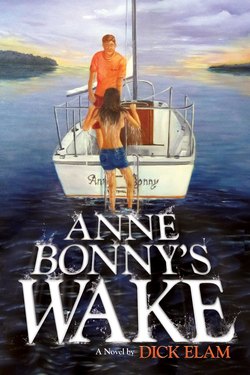Читать книгу Anne Bonny's Wake - Dick Elam - Страница 11
На сайте Литреса книга снята с продажи.
ОглавлениеCHAPTER 5
Barely smelled a gasoline odor.
Better to make sure there were no fumes. From the cockpit, I called down the old refrain: “While you’re in the hatch . . .”
Maggie looked up, and I said, “Would you please flip that switch that’s marked ‘bilge blower’?”
She turned from the stove and found the switch. I listened in the cockpit until I heard the exhaust fan.
“Thank you. We’ll get under way in about five minutes.”
I took covers off the jib winches. Both cloth covers smelled of mildew. Brass needed burnishing, also.
The charterer had installed roller-furling gear to wind up the large Genoa foresail. From the cockpit, I could pull a line and roll up the front sail, same way you roll up a window shade. Or ease the line and let the sail unwind and fill. Good device for sailing alone.
I looked to make sure the Bear was indeed gone before I went below. My “swim-aboard mermaid” worked in the galley area. Maggie Adelaide Moore wedged foodstuffs and utensils to keep them from rolling. Told me she had sailed offshore as well as motored in the Waterway. I wondered if she’d learned her seamanship on a fast-moving motor yacht or on a slow cruising sailboat. My Annie had enjoyed going only five knots in this Anne Bonny, often slower. “When you’re not rushing through life, you smell trees on the shore, hear chirps from the birds,” she’d often reminded me.
This newest galley slave on Anne Bonny had removed her padding. My sweatshirt draped her chest, leaving only a trace of bust line. Maggie had also removed my longer sailing shorts and donned her cut-off jeans. My sweatshirt draped halfway down her cutoffs. I made a suggestion:
“If you look in the hanging locker, you will find another orange T-shirt like the one I’m wearing. Medium size, a better fit than that heavy sweatshirt.”
“Thanks. Will do,” she said. “By the way, I’m curious about that skull and flower printed on your sleeve. What does the black flower between the teeth signify?”
Annie had paid our Carolina artist friend, David Haynes, to design the skull with a black rose in her teeth. The boat name we had printed, in black, on the front of the orange T-shirt.
“Female pirate ship. Anne Bonny was a ruthless, female pirate.”
“Really? Well, that sure sounds interesting, Captain.”
I liked to tell the Anne Bonny story, but now I wanted to get under way.
“Why don’t you come up to the cockpit? I don’t start this gasoline motor with crew below.” I collected the ignition key, the throttle pin insert. Smelled the engine. The bilge blower still hummed. Reduced my worry about gas fumes.
I climbed into the cockpit. Maggie soon followed. She had donned the orange T-shirt. The size may have been medium, but the cloth stretched tight across her chest.
I showed her how to operate the throttle and the gearshift. Don’t think I needed to instruct, but she posed like an attentive student. When I get under way alone, I start the engine, leave the gear in neutral, and go forward and pull the anchor hand over hand. With a crew aboard, you can power up to the anchor, pull up line, and let the boat’s forward momentum help lift the anchor.
I started the engine, left Maggie to work the tiller and throttle, and went forward. She understood my hand signals and powered forward. I pulled up and washed the anchor in the bow wave. She followed my signal and steered the boat into the Pamlico Sound.
Single-handed, a skipper can boast of self-sufficiency, but I preferred to sail with a crew. Annie had said I wanted to blame someone for my mistakes. Probably correct. I often declared, when sailors gathered for an after-race cocktail, “It’s the skippers what win the races, and the crews what loses ’em.”
Annie had countered by announcing herself as president of the Crews Union. Their motto: “The Skipper always goes down with the ship.”
I went aft and asked Maggie to steer into the wind so I could raise the mainsail.
Maggie needed no additional instruction. She pushed the tiller and steered into the wind. Her eyes watched the wind vane swing at the mast top. She throttled back, placed the tiller between her legs, and un-cleated the mainsail line. With her knees, Maggie steered closer into the wind. I unfurled and raised the mainsail. Maggie shifted the tiller and moved the bow away from the head wind. The mainsail filled, and Maggie adjusted the mainsheet.
Maggie Moore knew her way about sailboats. And the Anne Bonny responded as if she knew that her reins were in competent hands.
“Good work. We’re on course for Oriental,” I told her. Turned off the motor, un-cleated the jib sail roller furler, hauled on the Genoa sheet, and the forward sail unfurled.
The wind from the Atlantic freshened. The sloop heeled to her waterline. We reached down the Sound. The Anne Bonny galloped freely, lifted her nose over the waves, tossed back spray, pleased to have a woman again at her helm.
